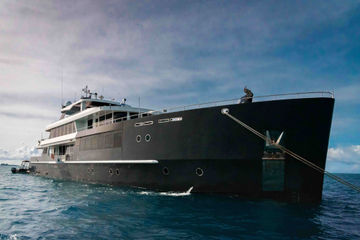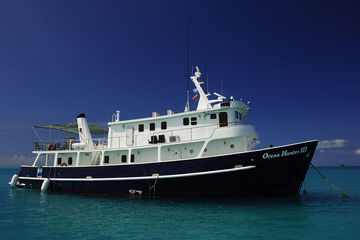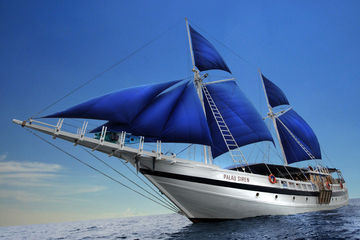Snorkeling in Micronesia
Snorkeling in Micronesia
Thousands of picturesquely tropical islands strewn across miles of warm, blue waters of the western Pacific Ocean make for fantastic snorkeling in Micronesia.
Named for the Greek for 'small island', Micronesia is made up of the five independent nations of Palau, the Federated States of Micronesia, Kiribati, the Marshall Islands and Nauru, as well as several U.S. territories, having come a long way from the first time non-islanders set foot on the white sands here in 1521, when the Portuguese explorer Ferdinand Magellan came ashore in search of the spice islands.
Most of these stunning islands were formed from coral reefs that fringed partially submerged volcanoes, left behind on the surface of the ocean when the volcanic peak sank back into the sea. Today Micronesia snorkeling and scuba diving is some of the best in the world, with shallow, prolific reefs and coral gardens teaming with the abundance and diversity of marine life that you'd expect within the Coral Triangle (a Pacific sea creature hotspot).
7 Snorkeling Cruises in MicronesiaExplore all liveaboards
Marine Life In Micronesia
The tranquil, crystalline seas that frame the many islands of Micronesia boast blooming reefs alive with colorful soft and hard corals and sponges, which are home to clownfish-filled anemones, reef sharks, several species of sea turtles, enormous Tridacna clams (possibly more than a hundred years old), cuttlefish, octopuses, eagle rays, moray eels, lionfish and dolphins, just to name a few.
If you go snorkeling in Micronesia in April around the full moon, you might be lucky enough to coincide with annual coral spawning on the reefs on night, when shallow ocean waters are almost turned pink by as the coral polyps emit a huge cloud of egg and sperm, to colonize new reefs.
During the winter months of December through April, during their mating season, the chance of spotting a Manta ray on a snorkel tour is definitely higher.
Although shy and solitary, Dugong, tend not to stray far during their lifetime, so a snorkeling tour among the shallow seagrasses on many islands could offer a personal encounter with the creature that may have produced the legends of mermaids.
And any snorkel trip to Micronesia will have the compulsory stop along route to swim through the endless, pulsating pink clouds of stingless Mastigias jellyfish at Jellyfish Lake. Having been cut off from the ocean since the ice age, a lack of predators in the lake means they've lost the need for their protective sting.
Best Snorkel Sites in Micronesia
The jungle-capped Rock Islands, a UNESCO world heritage site, are a group of over 400 tiny, uninhabited limestone isles topped with lush green vegetation and surrounded by clear, warm, reef-filled water, making them a top-class Micronesia snorkel site. Amid this labyrinth of islets the calm emerald lagoons conceal a rainbow of corals hosting a myriad of tropical fish. And with some luck you may catch a rare glimpse of the legendary Dugong.
Also in the Rock Islands is truly some of the best snorkeling in Micronesia, at Palau's famously unique Jellyfish Lake. Known locally as Ongeim'l Tketail, on the island of Eil Malk, the lake is jam-packed with thousands of stingless Golden Jellyfish (Mastigias sp.).
No trip to Micronesia would be complete with out visit to snorkel ghost fleet of Truk (Chuuk) Lagoon, the site of the famous WWII air raid Operation Hailstone in 1944 where more than 60 ships were sunk and hundreds of planes went down. Nowadays these historic wrecks are decorated with stunning corals and are home to an array of marine life.
Snorkeling at German Channel offers the chance to see the graceful birdlike Manta rays. A fringing reef close to the drop off into the deep water, filled with nutrient rich water, attracts these ocean giants to feed, as well get a good polish at the nearby cleaning station that is popular with diver, though sadly too deep for snorkeling.
Best Time To Snorkel in Micronesia
Snorkeling in Micronesia is amazing at any time of year, with warm 24-29C (75-90F) temperatures year around, with sea breezes and trade winds to take the edge off the humidity. The dry season in the islands is typically between January and June. As Micronesia lies partly in the Typhoon belt, the rainy season can sometimes include typhoons, particularly between August and December.
Waters around the islands are a balmy 28C (83F) all the time and the visibility is rarely anything less than impressive.
How Do I Get To Micronesia
On of the best ways to snorkel in Micronesia is from a liveaboard. The principal entry point into Palau is through the Roman Tmetuchl International Airport on the island of Babeldaob, a short drive from the Koror. Flying to Palau means booking flights through the Philippines, Taiwan, South Korea, Japan or Guam. Once in Koror you are ready to explore the wonders of Micronesia snorkeling from land or on a liveaboard departing from one of the many marinas on the island.
For snorkeling trips to Truk Lagoon you'll fly into the small Chuuk International Airport in Weno, the largest city in within the Federation of Micronesia, with the main route being via Guam from Honolulu, Hawaii.












